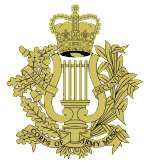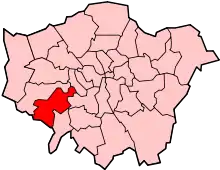Royal Military School of Music
The Royal Military School of Music (RMSM) trains musicians for the British Army's twenty-two bands, as part of the Corps of Army Music. It is based at Kneller Hall, in Twickenham, west London; however, the Ministry of Defence has recently indicated that the site will be sold, and the school moved elsewhere.
| Royal Military School of Music | |
|---|---|
 | |
| Active | 1857 – present |
| Country | |
| Branch | |
| Type | Training |
| Role | Teaching music |
History

The RMSM was established in 1857[1] at the instigation of Prince George, Duke of Cambridge, who was Queen Victoria's cousin and commander-in-chief of the army. In 1854, during the Crimean War, he attended a parade in Scutari, Turkey to celebrate the Queen's birthday, where approximately 20 British Army bands on parade were required to combine in a performance of the national anthem. The custom at this time was for regiments to hire civilian bandmasters, each of whom had free rein in their band's instrumentation and arrangements. With each band playing God Save the Queen simultaneously in different instrumentations, pitches, arrangements and key signatures, the result was an embarrassing and humiliating cacophony.[2] The Duke decided there should be some standardisation in army music, and so formed the RMSM, with Henry Schallehn (who also became the first director of music at the Crystal Palace) as commandant. For several years in the late 19th century, the commandant was Colonel T. B. Shaw-Hellier, owner of the Hellier Stradivarius.[3]
In 1937 the school commissioned a new set of custom-made fanfare trumpets, designed by Lt-Col. Hector Adkins (Director of Music 1923-1941), along with a matching set of valved trombones. First appearing at the Coronation of King George VI that year, the Kneller Hall Trumpeters went on to be a regular feature of state occasions and national celebrations throughout the twentieth century. A distinctive banner, designed for the School by Kruger Gray, was hung from each instrument and made the trumpeters very recognisable: it consisted of a shield displaying three clarions beneath a crown.[4]
Present day
The RMSM has spent a century and a half at Kneller Hall, which was the country house of the court painter Sir Godfrey Kneller and was rebuilt after a fire in 1848.
The school is open to men and women whose commitment to the army is for a minimum of four years. The Corps of Army Music, the largest employer of musicians in the United Kingdom, promotes itself to potential recruits as an opportunity to earn a salary as a musician. The school's curriculum is not limited to martial music, but includes jazz, swing, middle-of-the-road, popular, baroque, mainstream symphonic and operatic music.
Museum of Army Music
The Museum of Army Music at Kneller Hall has a collection of instruments, music, banners, medals, model bands, documents, prints, manuscripts, paintings and uniforms illustrating the history of military music. It is open to the public Wednesday afternoons and by appointment.[5][6]
See also
References
- Twickenham Museum: Kneller Hall
- Royal Military School of Music former website
- "Band Gossip for Far and Near". Star. 2 April 1898. p. 6. Retrieved 14 February 2016.
- "The Kneller Hall Trumpeters". Friends of The Museum of Army Music. Retrieved 1 October 2020.
- Army Museums: Royal Military School of Music Museum Archived 13 August 2007 at the Wayback Machine
- "Official site". Friends of Kneller Hall Museum. Archived from the original on 9 November 2014. Retrieved 24 March 2015.
Further reading
- Turner, Gordon & Alwyn W. Turner, (1996) The Trumpets will Sound: The Story of the Royal Military School of Music, Kneller Hall. Tunbridge Wells: Parapress ISBN 1-898594-38-4
External links
| Wikimedia Commons has media related to Royal Military School of Music. |
- Royal Military School of Music – on British Army official website
- Museum of Army Music
